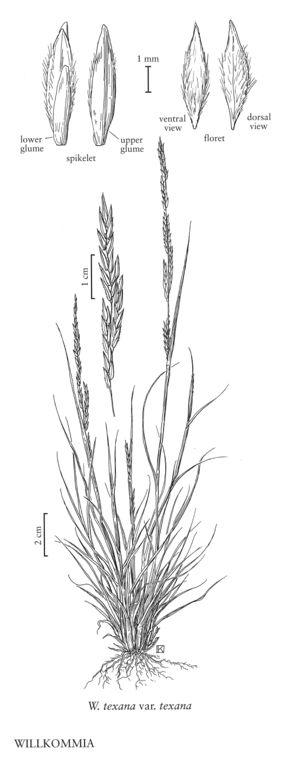Difference between revisions of "Willkommia texana"
FNA>Volume Importer |
GeoffLevin (talk | contribs) m (Add period to Hitchc. in authority) |
||
| (6 intermediate revisions by 2 users not shown) | |||
| Line 1: | Line 1: | ||
{{Treatment/ID | {{Treatment/ID | ||
|accepted_name=Willkommia texana | |accepted_name=Willkommia texana | ||
| − | |accepted_authority=Hitchc | + | |accepted_authority=Hitchc. |
|publications= | |publications= | ||
|common_names=Willkommia | |common_names=Willkommia | ||
| Line 17: | Line 17: | ||
-->{{Treatment/Body | -->{{Treatment/Body | ||
|distribution=Okla.;Tex. | |distribution=Okla.;Tex. | ||
| − | |discussion=<p><i>Willkommia texana</i> grows on clay pans, alkaline flats, and sandy soils, in open or bare areas of Texas and (rarely) Oklahoma and, as a disjunct, in Argentina. The Oklahoma record may represent a recent introduction. North American plants belong to <i>Willkommia texana</i> Hitchc. < | + | |discussion=<p><i>Willkommia texana</i> grows on clay pans, alkaline flats, and sandy soils, in open or bare areas of Texas and (rarely) Oklahoma and, as a disjunct, in Argentina. The Oklahoma record may represent a recent introduction. North American plants belong to <i>Willkommia texana</i> Hitchc. <i></i>var.<i> texana</i>. They differ from the Argentinean variety, <i>W. texana</i> var. stolonifera Parodi, in being cespi¬tose rather than stoloniferous.</p> |
|tables= | |tables= | ||
|references= | |references= | ||
| Line 26: | Line 26: | ||
-->{{#Taxon: | -->{{#Taxon: | ||
name=Willkommia texana | name=Willkommia texana | ||
| − | + | |authority=Hitchc. | |
| − | |authority=Hitchc | ||
|rank=species | |rank=species | ||
|parent rank=genus | |parent rank=genus | ||
| Line 33: | Line 32: | ||
|basionyms= | |basionyms= | ||
|family=Poaceae | |family=Poaceae | ||
| + | |illustrator=Linda A. Vorobik;Karen Klitz | ||
| + | |illustration copyright=Utah State University | ||
|distribution=Okla.;Tex. | |distribution=Okla.;Tex. | ||
|reference=None | |reference=None | ||
| Line 38: | Line 39: | ||
|publication year= | |publication year= | ||
|special status= | |special status= | ||
| − | |source xml=https:// | + | |source xml=https://bitbucket.org/aafc-mbb/fna-data-curation/src/200273ad09963decb8fc72550212de541d86569d/coarse_grained_fna_xml/V25/V25_360.xml |
|subfamily=Poaceae subfam. Chloridoideae | |subfamily=Poaceae subfam. Chloridoideae | ||
|tribe=Poaceae tribe Cynodonteae | |tribe=Poaceae tribe Cynodonteae | ||
Latest revision as of 17:46, 8 December 2021
Plants perennial; cespitose or stoloniferous. Culms (12)17-65 cm, glabrous; nodes 4-6(7), glabrous. Leaves cauline; sheaths mostly glabrous, upper margins sometimes pubescent; ligules 0.3-0.6 mm, truncate; blades (1)4-21 cm long, 0.6-3.5 mm wide, involute to flat, glabrous, margins pubescent. Panicles (6)7-34(44) cm long, 4-10 mm wide; branches 4-13(20), 1-8 cm, appressed, each branch usually terminating in a reduced, sterile spikelet, lowest branches usually partially enclosed in the uppermost sheaths at maturity. Spikelets 3.5-5 mm; disarticulation usually below the glumes, sometimes the first glume persistent. Lower glumes 2-3.5 mm, glabrous; upper glumes 3.3-4.8 mm, glabrous and smooth below, scabridulous above; lemmas 3.0-4.2 mm, usually appressed pilose between the veins, lateral veins obscure, midveins sometimes excurrent; paleas 2.5-3.4 mm, pubescent between the veins; anthers 3, 0.3-0.9(1.1) mm, yellow-orange. Caryopses 1.4-2 mm. 2n = 60.
Discussion
Willkommia texana grows on clay pans, alkaline flats, and sandy soils, in open or bare areas of Texas and (rarely) Oklahoma and, as a disjunct, in Argentina. The Oklahoma record may represent a recent introduction. North American plants belong to Willkommia texana Hitchc. var. texana. They differ from the Argentinean variety, W. texana var. stolonifera Parodi, in being cespi¬tose rather than stoloniferous.
Selected References
None.
